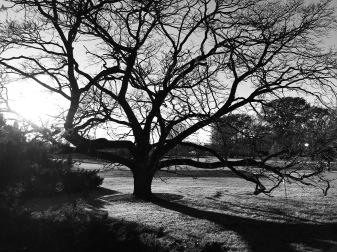How winter emphasizes the movements of wild life! The snow and the cold are the white paper upon which the print is revealed.
-John Burroughs, “Nature Near Home”

I only just learned that spiders don’t die every year when the temperatures reach freezing. That many types of spiders can actually stay alive as babies, fidgeting inside sealed eggs for warmth during the cold months. I thought they all froze to death. Perhaps if I dug around a bit in the soil I’d find some hiding, maybe playing cards or boiling soup, waiting for the cold to end.
But even if they are there, under us, I’m always relieved when the first frost comes and I won’t expect them around my apartment for a good five months. Chicago isn’t like Oklahoma, where black widows and fiddlebacks live in garages and linen closets year round. Chicago instead houses the furriest, biggest house centipedes I’ve ever seen, that scurry up walls and scare the cat when you’re expecting to, at least, find peace in the cold, both outdoors and in.
The backyard garden, once flush with vegetables and weeds, is full of sticks now that it’s winter, and the trees on my street are all bare and are only suited for crows and hawks. Bird nests are stripped of their protection, naked for all the world to see, hanging there sad and alone, until the wind from the lake slowly strips away each stick and leaf that was so carefully found and crafted into a home.
With all the living things that die in winter, it’s nice to think of the things that don’t. House succulents, for instance. Evergreen trees, though I have a dying Fraser fir in my living room, adorned with lights. Or dug up soil, always wet and alive under the surface in Chicago, it seems. Taking walks through nature preserves in the suburbs, various city parks, or the Morton Arboretum, has been a little unsettling; looking at the little black ID tags that proudly identify the thing that’s brown and dormant or dead, a crumbling shadow-formation of the plant it once was.
The Peggy Notebaert Nature Museum in Lincoln Park, usually surrounded by greens and tall grasses, birds and butterflies, is left somewhat alone in winter. I visited on a Thursday afternoon, mid-December, and there seemed to be no one around at all. The nature pond, usually surrounded by joggers and sun bathers, where I would run in the spring and summer when I lived a few streets over, sat still and alone in the cold tundra of the park, near but slightly removed from Lake Michigan. The first and second snows had melted, but the melting brought no illusion that the cold was gone. The museum building, hidden amongst the tall prairie grass, looking like some lost fort in a lost country, gave no outward signs of life, and seemed it could exist anywhere and nowhere at once.
But humans do praise the season changes, too. Leaf peeping in autumn is essentially celebrating the decaying of life, as these living things happen to be beautiful to us as they’re dying. We do the best we can with things we can’t control.
I did witness a form of birth on my trip to the nature museum this winter. I had never stepped foot into the butterfly haven, which is hot and humid and beating with forty species of exotic butterflies, sunbathing on the large windows with their wings spread, or gleefully soaring through air that isn’t frigid and windy. I had to take off my coat I got so warm.
I watched for “courting” butterflies, as the written guide told me to do, and I saw a couple blue butterflies doing just that; playfully chasing and mimicking one another as if no one or nothing else existed for those few moments. And the poor sunbathers, perhaps out of habit, stuck to the windows for a little sunlight despite the frigidity that doubtless seeped in through the glass they clung to.
When I left the room and checked myself in the mirror for lingering butterflies on my clothes, I entered another adjoining room, empty and cold, walls full of butterfly facts. I almost missed the wall of the butterfly births. Or transformations, really. The chrysalis rows hung behind glass like delicate roses being dried, upside down. Some browning, some green. Some butterflies still half in their pupa, and some fully emerged, wings spread for the first time upon landing at the bottom of the glass enclosure. When will these new butterflies be let out of here? I wondered, and almost wanted to set them free into the haven of fabricated humidity, where they would in turn spend their sheltered lives.


We also enjoy the butterfly habitat at the Tucson Botanical Gardens.